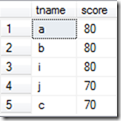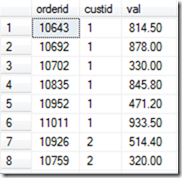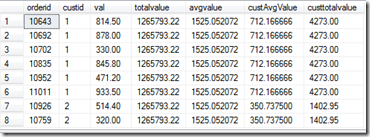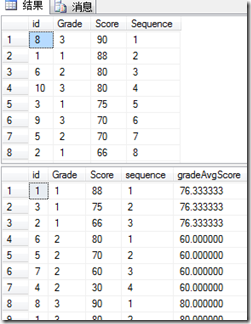[Sql Server 2008 基础] With Ties. Over()子句(转载)
with ties
WITH TIES指定从基本结果集中返回额外的行,对于 ORDER BY 列中指定的排序方式参数,这些额外的返回行的该参数值与 TOP n (PERCENT) 行中的最后一行的该参数值相同。只能在 SELECT 语句中且只有在指定了 ORDER BY 子句之后,才能指定 TOP...WITH TIES。
注意:返回的记录关联顺序是任意的。ORDER BY 不影响此规则
来源:MSDN,http://msdn.microsoft.com/zh-cn/library/ms189463.aspx
通俗解释
如果按照order by 参数排序TOP n(PERCENT)返回了前面n(pencent)个记录,但是n+1…n+k条记录和排序后的第n条记录的参数值(order by 后面的参数)相同,则n+1、…、n+k也返回。n+1、…、n+k就是额外的返回值。
举例说明
declare @tb table(tname varchar(10), score int)insert into @tb select 'a',80insert into @tb select 'b',80insert into @tb select 'c',70insert into @tb select 'd',60insert into @tb select 'e',50insert into @tb select 'f',40insert into @tb select 'g',40insert into @tb select 'h',30insert into @tb select 'i',80insert into @tb select 'j',70select top 4 * from @tb order by score desc
返回结果如下
. 但是我们发现 j的分数也是70, 这个时候我们需要统计j的时候, with ties就拍上用场了.
select top 4 with ties * from @tb order by score desc
Over子句
OVER子句用于为行为定义一个窗口(windows),以便进行特定的运算。可以把行的窗口简单地认为是运算将要操作的一个行的集合。例如,聚合函数和排名函数都是可以支持OVER子句的运算类型。由于OVER子句为这些函数提供了一个行的窗口,所以这些函数也称之为开窗函数。
简单的理解, 就是over提供了任意的聚合. 在一般情况下, 如果我们要用到聚合函数, 需要先使用groupby分组. 用了over之后, 某些情况就简单很多.
如果over()里面没有子句, 那么, over子句前面的聚合函数的操作窗口(可操作的数据行集合)为该次查询返回的所有行. over子句提供partition by进行分区. 其实就是把操作窗口(可操作的数据行集合)进行分组, 并匹配出符合分组参数的行集合. 那么我们来看例子.
我们想在后面加上几列数据以更好地支持我们的显示系统. totalValue(查询的所有价值之和), avgValue(查询的所有价值平均数),custAvgValue(某客户的订单价值之和),custTotalValue(某客户的订单价值平均)
declare @dt datetime;set @dt=GETDATE()SELECT orderid, custid, val,SUM(val) OVER() AS totalvalue,--所有行作为操作值AVG(val) over() as avgvalue,--所有行作为操作值AVG(val) over(PARTITION BY custid) as custAvgValue,--按客户ID进行分区, 并自动抽取出符合当前行的分区参数(这里是custid)的数据行SUM(val) OVER(PARTITION BY custid) AS custtotalvalue--按客户ID进行分区, 并自动抽取出符合当前行的分区参数(这里是custid)的数据行FROM Sales.OrderValues;--同样的效果, 用老式的方式进行查询select DATEDIFF(ms,@dt,getdate())set @dt=GETDATE()SELECT orderid, custid, val,(select SUM(val) from sales.OrderValues) AS totalvalue,(select avg(val) from sales.OrderValues) as avgvalue,(select avg(val) from sales.OrderValues where custid=s.custid) as custAvgValue,(select sum(val) from sales.OrderValues where custid=s.custid) AS custtotalvalueFROM Sales.OrderValues s;select DATEDIFF(ms,@dt,getdate())--表的数据为800多行. 第一种方式13-20ms. 第二种方式耗时40-50ms. 大数据量可见效率之差
partition by 和 order by连用.
sqlserver2005之后, 有一个排序函数, row_number() over(order by XX).
准备脚本
declare @Student table --学生成绩表
(
id int, --主键Grade int, --班级
Score int --分数)
insert @Studentselect 1,1,88
union all select 2,1,66union all select 3,1,75
union all select 4,2,30union all select 5,2,70
union all select 6,2,80union all select 7,2,60
union all select 8,3,90union all select 9,3,70
union all select 10,3,80--不分年级按学生成绩排名select *,ROW_NUMBER() over(order by Score desc) as Sequence from @Student--分年级按学生成绩排名,并取得年级平均成绩select *, ROW_NUMBER() over(partition by grade order by score desc) as sequence,AVG(score*1.0) over(partition by grade) gradeAvgScore from @Student
关于over子句和其他排名函数的使用请参考, 相当不错哦http://www.cnblogs.com/tylerdonet/archive/2011/07/08/2101384.html







【推荐】国内首个AI IDE,深度理解中文开发场景,立即下载体验Trae
【推荐】编程新体验,更懂你的AI,立即体验豆包MarsCode编程助手
【推荐】抖音旗下AI助手豆包,你的智能百科全书,全免费不限次数
【推荐】轻量又高性能的 SSH 工具 IShell:AI 加持,快人一步
· 如何编写易于单元测试的代码
· 10年+ .NET Coder 心语,封装的思维:从隐藏、稳定开始理解其本质意义
· .NET Core 中如何实现缓存的预热?
· 从 HTTP 原因短语缺失研究 HTTP/2 和 HTTP/3 的设计差异
· AI与.NET技术实操系列:向量存储与相似性搜索在 .NET 中的实现
· 周边上新:园子的第一款马克杯温暖上架
· Open-Sora 2.0 重磅开源!
· .NET周刊【3月第1期 2025-03-02】
· 分享 3 个 .NET 开源的文件压缩处理库,助力快速实现文件压缩解压功能!
· Ollama——大语言模型本地部署的极速利器